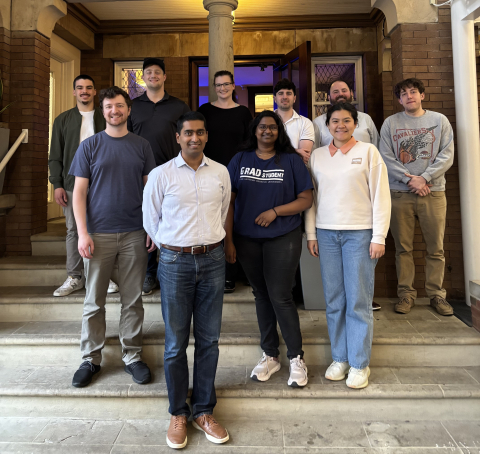The research interests of our group are centered around electrodeposition. Electrodeposition is a fascinating process in which ions give up their freedom to float around in a liquid electrolyte and condense into a dense, rigid crystal. Electrodeposition has numerous advantages: versatility to fabricate various materials, enable intricate pattern formation and even provide selective growth. Furthermore, ease of control and low cost make electrodeposition a process of choice in a broad range of applications: batteries, semiconductor devices, electrometallurgy and corrosion protection.
In spite of its wide use, fundamental understanding of the electrodeposition process is continually evolving. Physicochemical processes at the atomic-scale need to be fully understood to realize its full potential. An example of uncontrolled electrodeposition is dendrite formation. Needle-like dendrites evolve during electrodeposition of metals such as lithium and zinc. These can lead to short-circuit failures in lithium and zinc batteries thereby compromising safety. Mechanistically understanding and preventing dendrite formation is a major thrust of our research.
Electroplated copper is used to metallize nano-scale interconnects in advanced semiconductor devices. This process is remarkably complex, relying on a fine interplay between ppm levels of additives in the electrolyte to produce selective growth. We are interested in understanding how the additives function, and developing better additives for future applications. In future nano-electronics and electrocatalysts, the need to precisely control materials fabrication at the atomic-scale will become crucial. We are developing such advanced electrochemical processes in our laboratories.
Through a large industry-funded effort, we are also developing electroless processes for depositing environmentally benign, corrosion resistant, amorphous alloys. In electroless deposition, the electrons needed for the reduction process are supplied by an organic reducing agent rather than an external ‘electron pump’ (power supply). Naturally, one can use this technique for deposition of metals onto non-conductors or dielectrics.
Finally, we have initiated a major thrust on high-temperature molten-salt electrowinning of strategically important metals such as titanium and neodymium. In one such project funded by DOE ARPA-E, we aim to develop a stable and efficient process for electro-extraction of titanium metal from ore. For more details, read: https://engineering.case.edu/ARPA-E-titanium.
We are Hiring Postdoctoral Researchers!
The Electrochemical Materials Fabrication (EMF) Laboratory in the Department of Chemical and Biomolecular Engineering at Case Western Reserve University invites applications for a postdoctoral researcher position to conduct innovative research in the field of electrochemistry and electrochemical engineering. The EMF Lab at CWRU has research expertise in various areas including energy storage, atomically precise fabrication of materials, and high-temperature electrochemistry using molten salts. Examples of the EMF lab current projects include electrodeposition of metals from aqueous and non-aqueous (molten salts) media for a wide range of applications: nano-fabrication and critical materials production, modeling and electrolyte design for sodium battery systems, and electrochemical atomic layer deposition and etching.
Please visit our website and LinkedIn for updates and information on the group publications, projects, and achievements.
Required Qualifications
Ph.D. degree in Chemical Engineering or a related field
Strong track record of Ph.D. caliber research in electrochemical related areas
Responsibilities:
Conducts electrochemical experiments while maintaining safety as a top priority.
Complete data analysis and modeling.
Draw sound conclusions, communicate technical information effectively, and create compelling designs of experiments (DOEs).
Lead projects by establishing priorities, managing project timelines, and fulfill project reporting and compliance requirements.
Contribute towards peer-reviewed journal publications.
Collaborate with and mentor Ph.D. students and undergraduate researchers.
Participating in technical conferences, networking opportunities, and group meetings with detail-oriented presentations.
Maintain analytical equipment.
Demonstrate overall desire for professional development towards becoming an independent researcher.
To Apply
Submit a curriculum vitae (including two references) via email to Jennifer H. Stephenson at jxh762@case.edu with the subject line: EMFL Postdoctoral Application.
About Case Western Reserve University
Case Western Reserve University is located in Cleveland's University Circle, a square mile urban district of cultural, medical, educational, religious, and social service institutions. As an R1 university comprised of 8 schools with over 12,000 undergraduate, graduate and professional students, Case Western Reserve University has been ranked the #2 fastest growing research university according to NSF’s HERD survey. Case Western Reserve University has a long-standing reputation in electrochemistry and electrochemical engineering and has a vibrant research community working on many aspects of this field.

